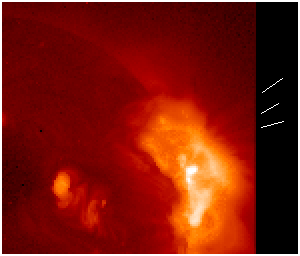Nobody needs to be reminded of the importance of good connections. It applies to energetic electrons, protons, and other particles, as well as politics. In the case of these charged particles, though, it's the magnetic field connections that matter. In the tenuous corona, charged particles are forced to follow magnetic field lines. The manner in which the magnetic field connects the Sun to the Earth, and what happens on those areas on the Sun that are well connected, is our subject today.
On November 8 the rotation of the Sun brought an active region (NOAA #9213), and a flare that occurred on that day, just to the solar footpoint of the magnetic field lines connected to the vicinity of the Earth. As a result, very high energy protons from that flare got to Earth very quickly, in large numbers. These protons are important to the Sun-Earth connection, since they are a danger to astronauts if they are not safe inside their spacecraft.
The arrival at Earth of very energetic particles from the Sun needs a bit of explanation. The solar wind blows outward from the Sun in all directions, and as it flows it drags some of the solar magnetic field out with it. This radial flow plus the Sun's rotation results in a pattern, which we call the Parker Spiral, after the solar physicist Eugene Parker who first explained it. Regions of outward and inward directed field alternately connect the Sun to the Earth, as the Sun rotates. Because these magnetic field lines have a spiral shape, solar energetic particle events preferentially appear (to us on the Earth) to happen in the solar west. See below for what happened on November 8th!
As we watch the Sun do its different amazing things, nowadays we're helped
by many organizations who generously and enthusiastically post their data
on the World-Wide Web.
One of our best resources for general monitoring is the
Today's Space Weather
page, an
entry point for the vast data holdings of NOAA's
Well, of course we are solar astronomers, so we like to point to things near the surface of the Sun. But what we see - sigmoids, flares, CMEs - of course are also intermediate stages on the propagation of the disturbance to the Earth. Ultimately there are ill-understood machinations in the solar interior (hard but not impossible; please check out helioseismology for a real science thrill). However our view of the solar interior is still a bit primitive, whereas we have great X-ray and EUV observations of the low corona now. Normally an event such as this would be eruptive, and we would see the beginnings of a CME flying out from the vicinity of a flare. In this case we have a data gap during the onset (the impulsive phase, where eruptions really accelerate). But we do have late-phase observations that reveal a good example of the large-scale magnetic reconnection process that results from the eruption. Yohkoh sees a well-developed spiky arcade:

The lines to the right guide the eye to the arcade's streamer-like spikes, which lie above the bright arcade loops. All of this is clearer in the "historical" section of the science nugget cited earlier. Within this fan-like structure, we see a downwards flow. We interpret this in terms of large-scale magnetic reconnection resulting from the eruption.
The "standard cartoon" for eruptive solar flares, due to Yohkoh's own K. Shibata, looks like this:

An alert reader will note that this cartoon does not show open field lines - so, solar energetic particles could never originate in such a structure and make it to the Earth in twenty minutes. Improvements are needed! Feel free to search the Grand Archive of Cartoons for a better one, or submit your own if you don't find any that work!
November 17, 2000
Hugh Hudson <hudson@isass0.solar.isas.ac.jp>